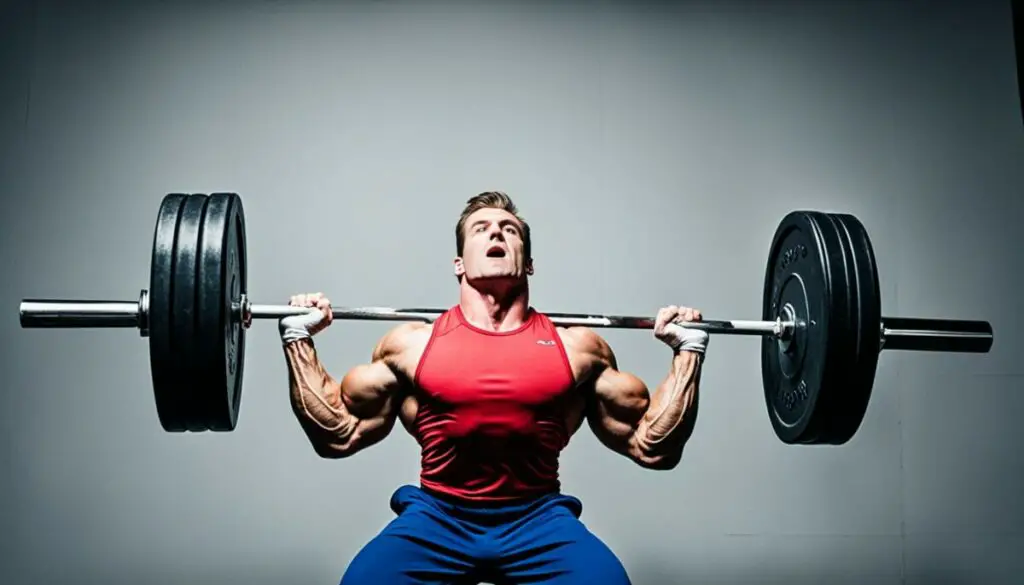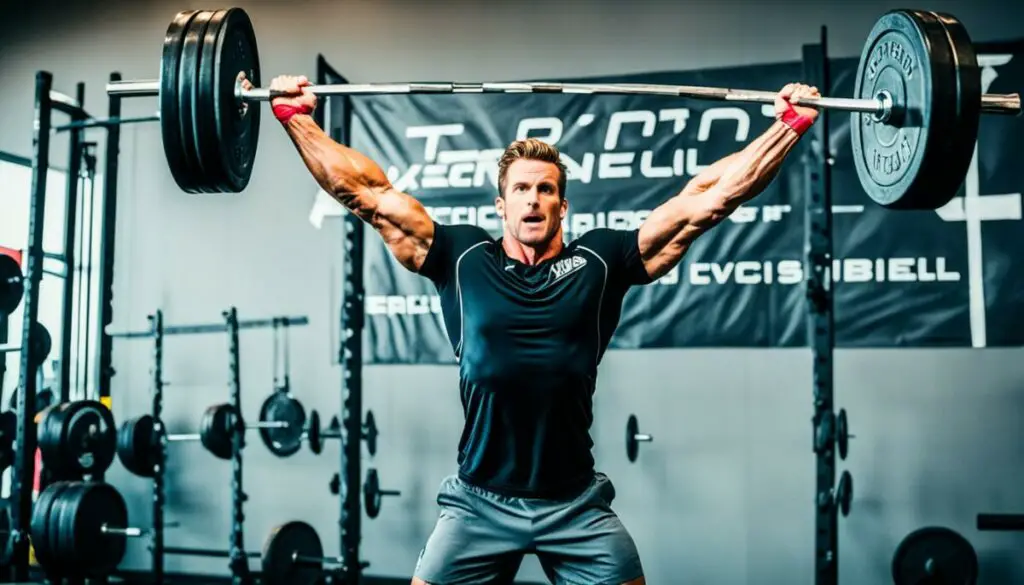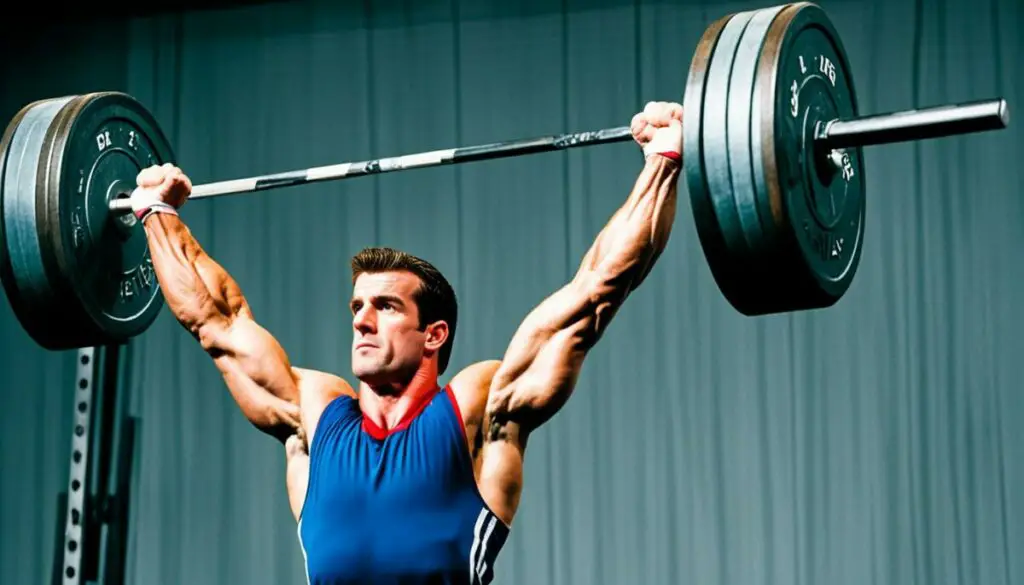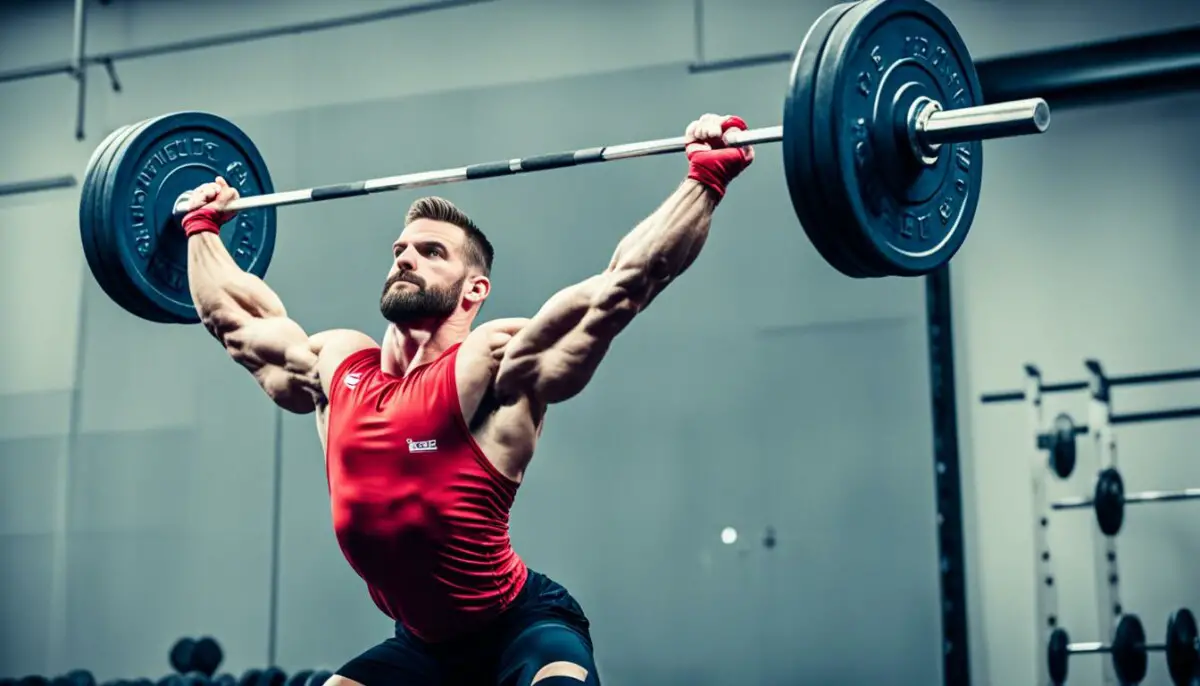Last Updated on 3 months by Francis
The high pull is a technique used in strength training that offers a variety of benefits. It involves lifting a barbell from the floor to shoulder height, focusing on explosive power and engaging multiple muscle groups. This article will explore the proper technique for performing high pulls, the benefits of incorporating them into your workout, and tips for maximizing your results.
Contents
Key Takeaways:
- The high pull is a strength training technique that involves lifting a barbell from the floor to shoulder height.
- High pulls target multiple muscle groups and improve explosiveness, power, and strength.
- Proper technique is essential to maximize benefits and minimize the risk of injury.
- High pulls can be incorporated into your workout routine as a compound exercise on upper body or full-body training days.
- Consult a fitness professional or healthcare provider if you have any pre-existing injuries or conditions.
Understanding the High Pull Movement

The high pull is a dynamic exercise that shares similarities with the clean and jerk movement in weightlifting. However, it differs by eliminating the catching phase of the clean and jerk. This compound movement starts with the barbell on the floor and involves a powerful extension of the legs, rising on the balls of the feet, shrugging the shoulders, and following through with the arms.
Unlike the clean and jerk, there is no need to turn over the wrists or catch the weight in the high pull. This exercise primarily targets the posterior chain muscles, including the hamstrings, glutes, and lower back. It also engages the traps, rhomboids, abdominals, delts, and other stabilizer muscles.
You can perform high pulls with different variations, grip widths, and equipment options, such as using barbells or dumbbells. This versatility allows you to tailor the exercise to your specific training goals and preferences.
To better visualize the high pull movement, refer to the following diagram:
Implementing proper technique is crucial for maximizing the benefits and reducing the risk of injury. The next section will delve into the step-by-step process of performing the high pull exercise correctly.
Benefits of High Pulls in Strength Training

High pulls offer numerous benefits in strength training. They effectively target and strengthen the posterior chain muscles, including the lower back, hamstrings, and glutes. By engaging these muscle groups, high pulls contribute to improved stability, power, and overall athletic performance.
In addition to working the posterior chain, high pulls also engage other essential muscles. The traps, rhomboids, abdominals, and delts are activated during high pulls, enhancing strength and stability in these areas. The exercise also activates various stabilizer muscles, which play a critical role in maintaining proper form and balance.
One of the primary benefits of incorporating high pulls into your workout routine is improved explosiveness. The explosive nature of high pulls helps develop fast twitch muscle fibers, which are essential for explosive movements in sports and other physical activities. By training explosiveness through high pulls, you can enhance your athletic performance, whether you’re sprinting, jumping, or performing quick directional changes.
High pulls also contribute to significant strength gains. As high pulls engage multiple muscle groups simultaneously, they provide a high pull muscles worked, ensuring comprehensive muscle development. Additionally, high pulls require coordination and balance, effectively challenging your core muscles and improving posture.
Another advantage of high pulls is their ability to increase training volume and repetition pool. By incorporating high pulls into your workout routine, you can add a new dimension to your strength training program. This variation in exercises can help break plateaus, stimulate muscle growth, and prevent boredom in your workout routine.
Overall, high pulls offer a range of benefits in strength training. They target the posterior chain muscles, engage stabilizer muscles, improve explosiveness, power, strength, balance, and posture, and provide a way to increase training volume and repetition pool. By incorporating high pulls into your workout routine, you can take your strength training to the next level and achieve your fitness goals.
Teaching and Learning the High Pull Technique

Proper technique is crucial when performing high pulls to maximize their benefits and minimize the risk of injury. Follow these steps to learn how to do a high pull with correct form:
-
Start with a shoulder-width stance, standing tall with your feet parallel.
-
Grip the barbell with an overhand grip just outside of your legs.
-
Maintain a slightly arched back, engaging your core muscles for stability.
-
As you initiate the movement, aggressively extend your hips and knees, driving the force from your lower body.
-
Keep your lats engaged and pull the bar up towards your chin, keeping it close to your body.
-
Focus on maintaining an explosive movement, emphasizing the extension of your hips and knees.
-
Elevate your elbows as you pull the barbell up, reaching a position where the bar is close to your chin.
-
Throughout the exercise, maintain a straight and neutral back, avoiding any rounding or excessive arching.
Mastering proper technique will help you get the most out of your high pull exercise. It is recommended to practice under the guidance of a qualified fitness professional to ensure correct form and prevent any potential risk of injury.
“By using the correct form when performing high pulls, you can target the intended muscles and avoid unnecessary strain. Engaging the lower body and maintaining a neutral spine are key components to achieve optimal results.”
High Pulls vs Other Strength Training Exercises
When it comes to strength training exercises, high pulls offer distinct advantages compared to other movements. Let’s take a closer look at how high pulls compare to the clean and jerk and the deadlift.
High Pulls vs Clean and Jerk
High pulls are similar to the clean and jerk, a popular weightlifting movement, but with one key difference—they eliminate the catching phase. This makes high pulls less technical and easier to learn compared to the clean and jerk.
“High pulls offer a great alternative to the clean and jerk, enabling athletes to focus on explosive power without the complexities of the catching phase,” says Jessica Martinez, strength and conditioning coach at FitStrong Performance.
By removing the catching component, high pulls place more emphasis on generating power through the initial movement, engaging multiple muscle groups in the process.
High Pulls vs Deadlift
High pulls and deadlifts share similarities in terms of targeting the posterior chain muscles, including the lower back, hamstrings, and glutes. However, high pulls place less stress on the lower back compared to deadlifts, making them a viable alternative for individuals with lower back issues.
“For individuals looking to target the posterior chain without compromising their lower back, high pulls can be a preferable option,” notes John Thompson, personal trainer and founder of StrengthHub.
High pulls offer benefits similar to the deadlift, such as improved strength, power, and muscle development, while minimizing the potential strain on the lower back.
Overall, high pulls can be a valuable addition to your workout routine, complementing exercises like deadlifts, squats, and rows. Incorporating high pulls into your training can provide variety, target different muscle groups, and support overall strength and power development.
Now, let’s explore some high pull variations that can further challenge you and enhance your training.
High Pull Variations for Increased Challenge

Once you have mastered the basic high pull technique, you can incorporate variations to add variety and increase the challenge. These variations not only keep your workouts exciting but also target different muscle groups and provide unique training stimuli to enhance your strength and power. Here are some high pull variations you can try:
- Dumbbell High Pulls: Instead of a barbell, use dumbbells to perform high pulls. This variation adds an element of instability, forcing your muscles to work harder to maintain control throughout the movement.
- Starting Position Variations: Instead of starting the high pull from the floor, you can begin from different positions like mid-thigh or knee height. By changing the starting position, you can focus on specific muscle groups and challenge yourself in new ways.
- Grip Width Adjustments: Experiment with different grip widths during high pulls. A wider grip targets the muscles of the back and shoulders, while a narrower grip places more emphasis on the arms and forearms.
Feel free to combine these variations or explore new ones based on your fitness level and goals. Challenge yourself and keep pushing your limits to continue making progress and see results.
High Pull Variation Table
| Variation | Muscle Groups Targeted | Brief Description |
|---|---|---|
| Dumbbell High Pulls | Back, Shoulders, Arms | Perform high pulls with dumbbells instead of a barbell to add instability and challenge your muscles. |
| Starting Position Variations | Targeted based on starting position | Begin the high pull from mid-thigh or knee height to place emphasis on specific muscle groups and change the exercise’s dynamics. |
| Grip Width Adjustments | Back, Shoulders, Arms | Experiment with wider or narrower grip widths to shift the focus of the exercise onto different muscle groups. |
High Pulls for Sports Performance Enhancement

The incorporation of high pulls into sports-specific training programs has gained popularity among athletes and sports coaches. This exercise has proven to be effective in improving explosiveness and force application, two crucial components in sports such as sprinting, jumping, and change of direction. By performing high pulls, athletes can enhance their ability to generate force and efficiently transfer it into the ground, leading to improvements in speed, agility, and overall performance on the field or court.
Including high pulls in your training routine can provide several benefits that directly contribute to sports performance. The explosive nature of the exercise helps athletes develop the power necessary for quick and explosive movements. Additionally, high pulls engage the posterior chain muscles, including the hamstrings, glutes, and lower back, which are essential for generating force and maintaining stability during athletic movements.
The versatility of high pulls allows for customization based on specific sport requirements. Athletes from various sports, such as soccer, basketball, and track and field, can benefit from incorporating high pulls into their training routines. By targeting the muscles and movement patterns relevant to their sport, athletes can develop the necessary strength, explosiveness, and coordination to excel in their chosen discipline.
Testimonial from a Professional Athlete:
“Incorporating high pulls into my training routine has been a game-changer. It has helped me improve my explosive power, especially during sprinting and change of direction movements. I feel more confident on the field and have noticed a significant improvement in my performance. I highly recommend adding high pulls to any athlete’s training program.”
To maximize the benefits of high pulls for sports performance enhancement, it is crucial to focus on proper technique and gradually increase the intensity of the exercise over time. Working with a qualified strength and conditioning coach can provide personalized guidance and ensure optimal results.
| Sports Performance Benefits of High Pulls |
|---|
| Improved explosiveness and power |
| Enhanced force application into the ground |
| Strengthened posterior chain muscles |
| Increased strength and stability in sport-specific movements |
| Enhanced speed, agility, and overall performance |
By incorporating high pulls into your sports training program, you can take your athletic performance to the next level. Whether you’re a professional athlete or a recreational sports enthusiast, the benefits of high pulls are undeniable. Consult with a knowledgeable coach or trainer to ensure proper form and integration into your training routine.
Incorporating High Pulls into Your Workout Routine

To take advantage of the benefits that high pulls offer, consider adding them as a compound exercise on upper-body or full-body training days. High pulls can be a valuable addition to your workout routine, helping you build strength, power, and explosiveness.
When incorporating high pulls into your training, it is important to start with lighter weights to focus on mastering proper technique. This will ensure that you engage the correct muscle groups and perform the movement safely. Gradually increase the load as your form and strength improve.
Aim to perform 2-3 sets of 8-12 reps of high pulls in each workout. Each repetition should be explosive and powerful, driving the barbell or dumbbells from the starting position to shoulder height with maximum force.
You can incorporate high pulls into your workout routine in different ways. They can be performed as a standalone exercise, or included as part of a superset or circuit to increase the intensity of your training.
Sample High Pull Workout Routine:
- Warm-up: Perform dynamic stretches and mobility exercises to prepare your body for the workout.
- Exercise 1: Squat (3 sets of 8-10 reps)
- Exercise 2: High Pull (3 sets of 8-12 reps)
- Exercise 3: Push Press (3 sets of 8-10 reps)
- Exercise 4: Romanian Deadlift (3 sets of 10-12 reps)
- Exercise 5: Bent-Over Row (3 sets of 10-12 reps)
- Cool-down: Stretch the muscles worked during the workout to aid recovery and prevent muscle stiffness.
Remember, proper form and technique are essential when performing high pulls. Pay attention to your body’s signals and adjust the weight and intensity accordingly. If you are unsure or new to high pulls, consult with a qualified fitness professional for guidance.
Continue reading to learn about common mistakes to avoid when performing high pulls and safety considerations to keep in mind during your training.
Common Mistakes to Avoid when Performing High Pulls
While high pulls can be a highly effective exercise for improving strength and power, there are some common mistakes that you should avoid to ensure optimal results and prevent injuries. By identifying and rectifying these errors, you can maximize the effectiveness of your high pull workouts and minimize the risk of setbacks.
1. Rounding the Back
Avoid rounding your back during high pulls, as this can compromise your form and place excessive stress on your spine. Maintain a neutral spine throughout the movement by engaging your core, keeping your chest up, and avoiding any excessive rounding or arching of the back. This will help distribute the load evenly and protect your lower back from undue strain.
2. Over-Reliance on Upper Body Strength
High pulls should primarily be driven by the explosive power generated from your lower body, specifically your hips and legs. Avoid relying too much on your upper body strength to initiate the movement, as this can lead to inefficient and ineffective execution. Instead, focus on utilizing the power from your lower body to generate momentum and propel the barbell upward.
3. Using Excessively Heavy Weights
It’s crucial to select an appropriate weight that allows you to maintain proper form and control throughout the entire range of motion. Using excessively heavy weights can compromise your technique and increase the risk of injury. Start with lighter weights to master the correct form and gradually increase the weight as your strength and proficiency improve.
4. Neglecting Muscle Engagement
Engaging the appropriate muscles is key to performing high pulls correctly. Make sure to activate your hip muscles, such as your glutes and hamstrings, to generate power and initiate the upward pull. Additionally, keep your shoulders engaged and your elbows elevated to properly engage the upper body muscles. By focusing on muscle engagement, you can maximize the effectiveness of each repetition and promote balanced muscle development.
5. Lack of Control and Coordination
High pulls should be explosive and powerful, but they should also be controlled and coordinated. Avoid using a jerking or swinging motion to lift the weight, as this can compromise your control and increase the risk of injury. Instead, maintain a smooth and controlled movement, emphasizing the explosive extension of your hips and knees to generate force. This will ensure that you can effectively handle the weight and maintain proper form throughout the exercise.
By avoiding these common mistakes, you can perform high pulls with proper form, maximize their effectiveness, and reduce the risk of injuries. Incorporate these tips into your high pull workouts to optimize your results and take your strength and power training to the next level.
| Mistake | Explanation |
|---|---|
| Rounding the Back | Rounding the back puts undue stress on the spine and compromises form. |
| Over-Reliance on Upper Body Strength | High pulls should be primarily driven by lower body power. |
| Using Excessively Heavy Weights | Select an appropriate weight to maintain proper form. |
| Neglecting Muscle Engagement | Engage the appropriate muscles, especially the hips and upper body. |
| Lack of Control and Coordination | Perform high pulls with control and coordination, avoiding jerking or swinging motions. |
Safety Considerations and Precautions for High Pulls
When incorporating high pulls into your strength training routine, it’s important to prioritize safety and take necessary precautions to minimize the risk of injury. By following proper form and technique, you can maximize the effectiveness of the exercise while safeguarding your well-being.
Here are some essential safety considerations and precautions to keep in mind when performing high pulls:
- Start with an Appropriate Weight: Begin with a weight that allows you to maintain control and stability throughout the movement. This will help you establish the correct form and prevent excessive strain on your muscles and joints.
- Gradually Increase the Load: As your strength and skill improve, you can gradually increase the weight used for high pulls. However, it’s crucial to progress incrementally and avoid making sudden jumps in intensity to prevent overexertion and potential injuries.
- Consult with a Qualified Professional: If you have any pre-existing injuries or medical conditions, it’s advisable to consult with a qualified fitness professional or healthcare provider before adding high pulls to your workout routine. They can provide personalized guidance and ensure the exercise is suitable for your specific needs.
- Listen to Your Body: Pay attention to any discomfort, pain, or unusual sensations during the exercise. If you experience any discomfort, it’s important to stop immediately and assess whether adjustments in form, weight, or technique are necessary.
- Perform a Warm-up: Always warm up your muscles and joints before engaging in high-intensity exercises like high pulls. This can increase flexibility, prepare your body for the movement, and reduce the risk of strains or pulls.
- Maintain Proper Form: Emphasize correct technique throughout the exercise, focusing on keeping your back straight, engaging your core, and avoiding excessive swinging or jerking motions. This will help distribute the load evenly and minimize stress on specific muscles or joints.
By adhering to these safety considerations and precautions, you can enjoy the benefits of high pulls while minimizing the risk of injury and ensuring a safe and effective workout experience.
Training Progression and Advanced High Pull Techniques
As you continue to refine your high pull technique, you can explore advanced techniques and training progressions to further challenge yourself and continue your strength development. By incorporating these strategies into your workouts, you can take your high pulls to the next level and achieve even greater results.
Combining High Pulls with Jumps and Plyometric Exercises
To add complexity and enhance the explosiveness of your high pull movements, consider combining them with jumps or plyometric exercises. This combination trains your muscles to generate power from a fully extended position, mimicking real-life athletic movements.
“Incorporating jumps or plyometrics into your high pull routine can enhance your explosive power and improve your overall athletic performance.”
Start by performing a high pull, and as you reach the top of the movement, transition smoothly into a vertical jump or a plyometric exercise like box jumps. This dynamic combination challenges your coordination, power output, and overall athleticism.
Experimenting with Different Tempos and Time Under Tension
Variations in tempo and time under tension can provide new training stimuli and further intensify your high pull workout. By adjusting the speed at which you perform the movement and the duration in which your muscles are under tension, you can target specific muscle fibers and enhance your muscular control.
- Slow Eccentric Phase: Focus on lowering the barbell slowly during the eccentric phase of the high pull. This increases the time under tension, leading to greater muscle fiber recruitment and emphasizing muscle control and stability.
- Explosive Concentric Phase: Place emphasis on the explosive lifting phase of the high pull. Generate as much power as possible while maintaining proper form. This variation enhances the recruitment of fast-twitch muscle fibers responsible for generating explosive force.
Unilateral High Pull Variations
Unilateral high pull variations involve performing the exercise with one arm at a time. This variation challenges your core stability, coordination, and muscular balance. It also allows you to identify and correct any muscle imbalances that may exist between your left and right sides.
To perform unilateral high pulls, use dumbbells or a kettlebell instead of a barbell. Focusing on one side at a time increases your concentration and engagement with each repetition, enhancing your mind-muscle connection.
| Benefits of Unilateral High Pulls: |
|---|
| Improved muscle coordination and balance |
| Enhanced core stability and unilateral strength |
| Targeted identification and correction of muscle imbalances |
Remember to perform the same number of repetitions on each side to maintain balance and ensure symmetrical development.
By incorporating advanced high pull techniques and training progressions into your workouts, you can continue to challenge yourself and make significant strides in your strength training journey. Whether it’s combining high pulls with jumps, experimenting with different tempos, or performing unilateral variations, these strategies will push your limits and help you achieve your fitness goals.
Conclusion
The high pull is a versatile and effective exercise that can greatly enhance your strength training routine. By mastering the proper technique and gradually increasing the load, you can experience a wide range of benefits. Whether you’re a beginner or an advanced lifter, incorporating high pulls into your workouts can improve your strength, explosiveness, and sports performance.
One of the key advantages of the high pull is its ability to engage multiple muscle groups simultaneously. This compound movement targets the posterior chain muscles, such as the lower back, hamstrings, and glutes. Additionally, it works the traps, rhomboids, abdominals, and delts, among others, to enhance your overall physique and muscle development.
As you integrate high pulls into your workout routine, prioritize safety and listen to your body. Make sure to maintain proper form at all times, keeping your back straight and engaging the necessary muscles. If you’re unsure about the correct technique or how to progress, consult with a fitness professional who can provide personalized guidance.
Ready to take your strength training to the next level? Start incorporating high pulls into your workouts and unlock their true potential. With dedication, consistency, and the right approach, you’ll reap the benefits of this powerful exercise and achieve the results you desire.
FAQ
What is the high pull technique?
The high pull is a strength training technique that involves lifting a barbell from the floor to shoulder height, focusing on explosive power and engaging multiple muscle groups.
How is the high pull different from the clean and jerk?
The high pull is similar to the clean and jerk but eliminates the catching phase. In the high pull, you do not turn over your wrists or catch the weight.
What muscles does the high pull work?
The high pull targets and strengthens the posterior chain muscles, including the lower back, hamstrings, and glutes. It also engages the traps, rhomboids, abdominals, delts, and other stabilizer muscles.
How do I perform a high pull?
To perform a high pull, start with a shoulder-width stance, grip the barbell just outside of your legs with an overhand grip, maintain a slightly arched back, and explosively extend your hips and knees while pulling the bar up to chin height.
What are the benefits of incorporating high pulls into my workout?
Incorporating high pulls into your workout routine can improve explosiveness, power, strength, balance, and posture. They also provide a way to increase training volume and repetition pool, leading to enhanced muscle development.
How do high pulls compare to other strength training exercises?
High pulls offer distinct advantages compared to exercises like the clean and jerk and deadlift. They are less technical and easier to learn than the clean and jerk, and they target the posterior chain muscles like the deadlift but with less stress on the lower back.
Are there variations of the high pull?
Yes, high pulls can be performed with various grip widths and using dumbbells instead of a barbell. They can also be done from different starting positions, such as mid-thigh or knee height.
Can high pulls improve sports performance?
Yes, high pulls can improve explosiveness and force application, making them valuable for athletes in sports like sprinting, jumping, and change of direction. Integrating high pulls into sports-specific training programs can lead to improvements in speed, agility, and performance on the field or court.
How should I incorporate high pulls into my workout routine?
Consider adding high pulls as a compound exercise on upper-body or full-body training days. Start with lighter weights and focus on mastering proper technique before gradually increasing the load. Aim for 2-3 sets of 8-12 explosive reps.
What are some common mistakes to avoid when doing high pulls?
Common mistakes to avoid include rounding the back, relying too much on upper body strength instead of driving the movement with the lower body, and using excessive weight that compromises form.
Are there any safety considerations or precautions for high pulls?
It’s important to maintain a neutral spine, engage the appropriate muscles, and select a weight that allows for explosive and controlled movement. If you have pre-existing injuries or conditions, consult with a qualified fitness professional or healthcare provider before incorporating high pulls into your routine.
Are there advanced techniques or progressions for high pulls?
Yes, as you become more proficient in high pulls, you can explore advanced techniques like combining them with jumps or plyometric exercises. You can also experiment with different tempos, time under tension, or unilateral variations to further challenge your strength and coordination.









